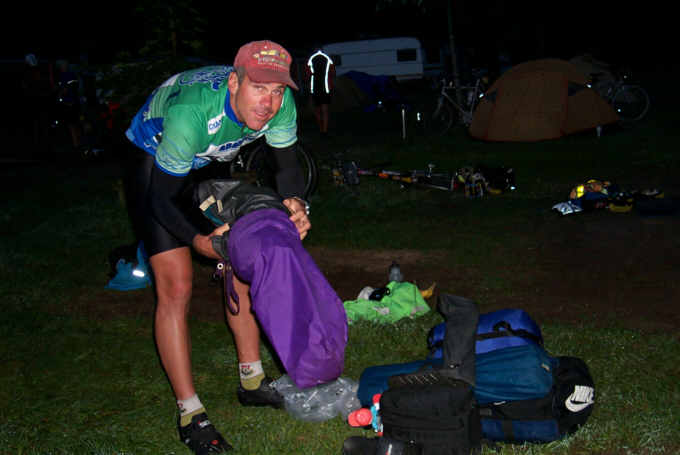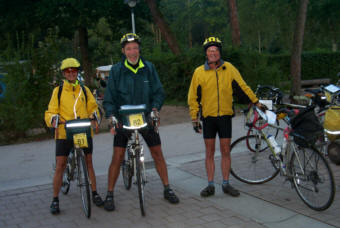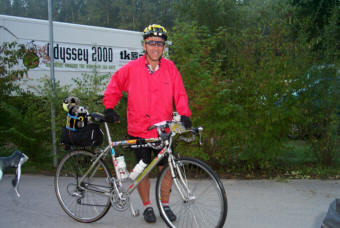

Page 81
Japan 
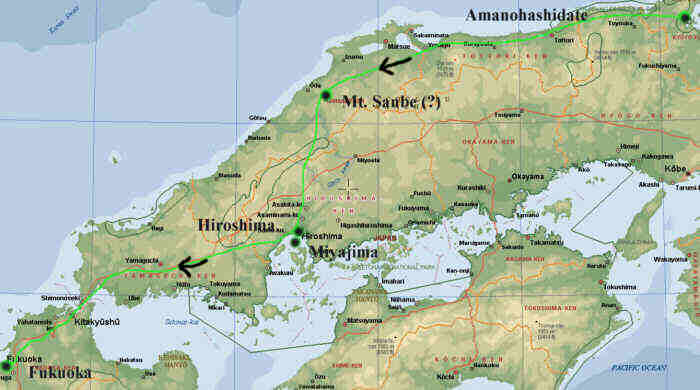
DAY
283
Amanohashidate to Mt. Sanbe
October
9, 2000
First a correction. Now that Iíve seen her name in print, I know that Dr. Jamesí wifeís name is spelled Kristi, not Christie.
It had rained in the night but not a drop leaked into my tent! The rain stood on the fly in tiny crystal beads, just like it should. My new plastic and foil ground cloth kept the floor dry. But of course I had to pack the tent wet. No one was sad to leave that camp site. We did have the TK&A showers and sinks, thank goodness, but we also had rented port-a-potties, only five for all of us. They were eastern style toilets, a trench in the plastic floor, a holding pan beneath. There was no way to flush, no lid to close. The stench was nearly unbearable, not to mention the disgusting, unavoidable view.
Breakfast arrived in the campground right on time, a box for each of us. The box was about a foot square with a clear plastic lid, the food neatly placed into the compartments of a black plastic square plate. In the largest compartment were two triangles of densely packed sticky rice. One had chopped greens mixed through it, the other had a hidden surprise in the center of salty dried fish. In a small compartment were sweet and sour noodles with plenty of onion, and in the last compartment, scrambled egg, a chunk of battered and deep-fried chicken, tender and mild shredded cabbage, and a taste of potato salad. It was all quite good actually, especially the noodles. We were each given a tiny can of cold green tea for a beverage. I kept reminding myself that it was good for me and managed to drink it all. It was bitter.
Then we were on a bus again, this time for a six or seven hour ride to Mt. Sanbe. No one knew why there and we couldnít find Mt. Sanbe in the guide books, so I think itís just a place to camp, a destination for a bicycling day. From my map I could see that it is a National Park. We donít know either whether we would have cycled on this road, but I hope not. There have been many long tunnels through the mountains, which would not have been pleasant to do on a bike. Bikes are prohibited from some tunnels but we donít know about these. We were told before departure that the bus would take the scenic coastal route rather than the expressway to avoid the toll fees that would have been nearly $1000 per bus. There were four buses. We may have done with three since some 40 or more people have gone Ďoff routeí to avoid the long bus rides. Some were taking the train to Hiroshima, bypassing the night in Mt. Sanbe. Some were taking a train to Kyoto or Osaka thus avoiding three long days in a bus. Those of us left behind are always glad the others are gone because it gives us more space and shortens lines. I had two seats on the bus to myself!
Most of us were content to be in the bus for a change, because it was pouring rain and misty, not good bike riding weather. The driver showed me the highway we were following on my map of Japan. We would pass through two of our former destinations, Tottori and Matsue, which had had to be eliminated because of the earthquake a few days ago. Weíd have had to give up two destinations anyway because of our delayed arrival in Japan. The road we traveled from Tottori to Matsue and then to Mt. Sanbe was the only road on the map so it is almost certainly the route we would have followed had we cycled.
We didnít see any cyclists from our vantage point in the bus although we thought Jim Higbee to be out there somewhere. He had ridden into camp in Amanohashidate on the second day, after completing the first 170km. of the ride. I didnít see him but others did. He had a disappointment when he found out that the bike he had bought was not a three speed afterall, but had only one speed. I donít know whether it was a used and broken bike, or a new bike. He is said to have consulted with Tim of TK&A about the route he should ride, and where to take a train, maybe to avoid the tunnels. I think he will have many stories to tell.
Every two or three hours the buses stopped at a rest area. The break was supposed to be 20 minutes but 200 people cannot move that quickly through the bathrooms and cash register. The first break required an hour. The drivers solved that problem by sending two buses to a different rest area for the second break. On that break I scored, finding a single small package of Oreos on the shelf. Chocolate has been hard to find. We havenít seen candy bar dispensing machines although dispensing machines are widely used. There are a great variety of beverages in the machines, both cold and hot. One can buy a can of cold coffee or a can of hot coffee, with or without sugar and/or milk. There are lattes and mochas and hot chocolate. There is every variation on tea imaginable and juices and sodas. Other machines dispense ice cream; some are Haagen Daz ice cream machines. I tried the choice marked NEW, it was a little cup of blueberry-frozen yogurt and I loved it. There are even machines that dispense film, disposable cameras, and batteries.
We havenít seen much of Japan of course, but one wonders how they manage to grow enough rice to meet their needs, if they do. The countryside we have passed through has been very hilly so that the rice fields are small and terraced when necessary. I know nothing about rice cultivation or the growing season here, but Iíve been surprised to see rice in all stages, from just barely showing green shoots to harvested and drying. The harvested rice is hung on short teepee shaped racks in the rice field right where the new crop is growing, perhaps because there is no space elsewhere to put the racks.
Nine hours after climbing aboard in Amanohashidate, we were still on the bus, it was dark and wet outside, we were high in the mountains but missing the scenery because of the darkness. We didnít know where the campground was or how weíd pitch our tents in the dark. People were starting to hope for indoor camping, someone else thought maybe the drivers would take pity on us and let us sleep on the bus.
Having fun in Japan?
Goodbye,
Alice
DAY
284
Mt. Sanbe to Hiroshima to Miyajima
October
10, 2000
The buses had come to a stop in the darkness and we were told to disembark. We did and there we stood, wondering where we were and where we would camp. It wasnít raining so it could have been worse. We were hoping that Tim of TK&A would have arrived ahead of us and would appear at any moment to tell us we had indoor camping. But that didnít happen. Eventually though Karen Ann came climbing up a bank, shouting that camping was that way, down the hill. In the darkness we scrambled down the hill and found a road that led to lights and an office. The bags were unloaded and we scurried to find tent sites. I found space in one of the first sites, there was an electric light near so I could just about see to pitch my tent. I rushed because it was raining and especially on my site because a great tall tree was dropping big blobs of cold water on me and my tent. Just as I finished Joan I. appeared and offered me a bed in the cabin she had rented. Darn! Too late! Then I headed back up the road toward Reception to get a boxed dinner and a can of cold brown tea. There was rice sprinkled with a few tiny black seeds, noodles, roast beef, a bit of potato salad and shredded cabbage. I found a space to stand and ate my cold supper. Karen Ann came around giving campers two 100 yen coins for a shower. Those who had cabins didnít need the coins. Then I went straight to my tent and had just climbed in when the downpour began. I was entertained with the patter of raindrops and the twang of bigger drops falling from the tree onto my tightly stretched fly.
It had been pitch dark when we arrived at 6:30 p.m. but it was already getting light 12 hours later, when I climbed out of my tent to have my first look at Mt. Sanbe National Park. It was a beautiful campground. Tent spots had been specially prepared by leveling the ground, then covering it with a coarse sand. There were trees and back among the trees were log cabins. The vine maples were already turning color. Peaks of high, pointed hills covered with green trees were all around us. It would have been a beautiful area to camp and hike.
I headed for the shower, clutching my two 100 yen coins and my shower kit. The shower was high-tech and awesome. I had a whole stall to myself with a lockable door. There was a wooden slat platform to stand on while showering which helps to keep feet warm and clean. In the corner was the hi-tech shower device. The shower head was on a hose so it could be held by hand or at one of the two levels on the console. There was a large mirror, perhaps Japanese men shave in the shower? Once the coins were inserted the time remaining showed in red digital numbers. I started with seven minutes. There were two buttons to push, START and STOP. Water temperature was regulated by a knob color-coded red and blue for hot and cold. There was even a shelf to hold soap and shampoo. I pushed START and STOP on and off between getting sudsy and rinsing, washed my hair and rinsed it, couldnít find anything else to do in the shower and still had four minutes remaining!
The toilets were in a separate building and while they were eastern style, a ceramic trench in the floor, they did flush so they were not disgusting to use. Still, they are not comfortable. One needs to have flexible knees to use an eastern toilet. Not all Japanese toilets are the eastern variety however. They do have the western style and these are designed to cater to oneís every need and desire. A simple one would have an electrically heated seat. That feels very nice! More complex models have a console alongside the seat with buttons to push for the functions available. One function is that the toilet can spray like a bidet. What a space saver that is for people who desire both a toilet and a bidet.
Breakfast was just a white bread sandwich with the crusts cut off, a carton of milk and a carton of juice. Cans of hot or cold coffee were available in a vending machine. Later while we sat on the buses waiting to go, extra sandwiches were distributed. Apparently there had been enough for two each. That was more like it!
We arrived in Hiroshima right on schedule. The buses stopped at the Peace Park and we were given two hours to see the park and museum, not really enough. I walked beside the Pond of Peace, past the Cenotaph for Atomic Bomb Victims, past the Flame of Peace, and toward the Atomic Bomb Dome which is on the other side of the Motoyasu River. But before reaching the river, just to one side, was the beautiful Childrenís Peace Monument. Standing atop the base, which to me at least resembled the nose-end of a bomb, is a child with up-stretched arms and in her hands is a dove lifting its wings to fly. Perhaps the child is Sadako Sasaki, the twelve year-old leukemia victim who folded 1000 paper cranes and more, because of the traditional belief that her wish to get well would be granted. It wasnít, but ever since school children all over the world have learned about her courageous effort and have folded paper cranes. At the Childrenís Peace Monument were scores of Japanese school children who knelt for a moment of silence or maybe of prayer, and draped over the low walls below the monument were thousands, and hundreds of thousands, of brightly colored paper cranes. It was a moving sight. The Hiroshima Peace Park is a beautiful monument and the museum is worth a visit too. I was amazed at how factual and unbiased the Japanese were about their role in making war on China, and about bringing prisoners of war or slaves into Japan to work toward the war effort. Many of those innocent people were also victims of the blast. The object of the display is to inform and to plead for the disarming of all nuclear weapons worldwide.
We were back at the bus at 3:00 but as ever, there was a delay. Underway at last, the buses took us to the ferry terminal where we disembarked and waited for the ferry to Miyajima Island, one of the three most beautiful places to visit in Japan. (Weíve now seen two of them.) It is Itsukushima Shrine and Otorii Gate which have earned this island its place in the top three tourist attractions. The shrine stands in the sea near the shore with the gate in the sea 200 meters before it. When the tide is high and the light is right it makes a stunning sight for the shrine appears to be floating. For us though the tide was out and from the ferry we could see only the gate and not the shrine.
The buses could not cross on the ferry so we had walked on and found minibuses on the other side waiting to shuttle us to camp. It was only 4 km. so many people, too impatient to wait for the buses, walked. I stopped at the ferry terminal where I found a good phone and succeeded on the third attempt in sending and receiving email. Then I went out to play with the deer. Tame deer wander on the island hoping for handouts. One came into the terminal where I was using a phone and tried to eat my papers. Outside I found a doe and her half-grown fawn. The young one was carrying a chunk of an enormous carrot in its mouth but couldnít eat it because it was too big. I found my knife and when the fawn dropped the carrot I snatched the slimy thing and cut slices for the two deer. They loved that and I had a wonderful time. Later at camp when our tents were up the deer were nosing into the tents. One became startled when the tentís owner returned and in itís panic broke a tent pole and ripped the fly. Another deer butted a man in the back when he stopped feeding it. I thought they were lovely and largely harmless. Having fun in Japan!
Goodbye, Alice
Day
285
Miyajima to Fukuoka
October
11, 2000
Luck was with us, it was not raining, and when the sun was high enough to reach us under the trees in the campground we were all up and waiting for it. This was the morning everything had to be cleaned and dried. All the camping equipment and everything else we could do without was going to be left in storage in Kuala Lumpur. We would get it later when we went to New Zealand where we would need it for camping. For the next six weeks we would be in Asia where every night would be a hotel night.
The campground was colorful with tents, sleeping bags and air mattresses spread to dry everywhere there was a ray of sunshine. Tame deer wandered about poking their noses into bags, looking for something good, which included paper. I saw one pick up a paper that was folded in quarters and munch it down in nothing flat.
Suddenly a big cheer came from the entrance to the camping area. We looked at each other and someone said, ĎJim must have come in.í I grabbed my camera and hurried there as did everyone else in camp. It was Jim and he looked great. He was applauded, congratulated and photographed by everyone. We plied him with questions about his ride which he patiently answered when what he probably really wanted to do was lie down somewhere. He posed for pictures with his one-speed Japanese city bike which he had bought just to ride in Japan. When asked what inspired him to do the ride and keep at it with his woefully inadequate bike for the steep climbs he had to do, he responded, ĎThe other EFI riders like Bill Bliss and Ruth Watson.í Jimís feat is the stuff of legends. Weíll be talking about him with awe in our voices forever.
Once our bags were packed they needed to be put into the appropriate truck. About half of us were going by bus in the afternoon to Osaka and the other half, including me, to Fukuoka. But no one knew which truck was for each destination so there was a wait until Tim of TK&A arrived to give directions. With my bags on a truck at last, I rode a minibus shuttle back to the center of Miyajima. We gathered there and when everyone had arrived we boarded the ferry for the crossing to Hiroshima. The views of the Otorii Gate and of Hiroshima were both spoiled by heavy air pollution.
We walked from the ferry directly to the parking lot where we stood in line to board the buses bound for Osaka and Fukuoka. I was one of the last onto the second Fukuoka bus and had to take a seat in the aisle on an uncomfortable jump seat. It jabbed my back and pinned my arms to my sides. It was lower than the regular seats so that the two young men on either side hemmed me in and appeared to be gigantic in size. Bus rides make me sleepy but there was nowhere to rest my head. I was thirsty and hungry and wished I had taken time to buy water before getting in line since I was nearly last anyway. Once the bus was loaded we sat in the parking lot and waited for I donít know what so that when we did leave we were already two hours behind schedule. The good news is that no one complained or raised a fuss.
The bus ride did come to an end of course, and dropped us at the Station Plaza Hotel, which seems to be near the center of the city. Fukuoka appears to be large, modern and bustling. At the outskirts we came through an area one rider described as ĎJapanís Las Vegasí. We were assigned two to a room rather than the usual 3,4 or 5 so that was a treat. My roommate, Sarah, who has lived and worked in Japan and speaks Japanese, was another treat.
The bags arrived shortly so I took mine to my room and hand washed a shirt and trousers to wear the next day, figuring that if they didnít get dry I would wear them anyway. That is preferable to packing them still damp.
Dinner was at 8:00 in a Chinese restaurant on the 12th floor of a building three blocks away. Some people were confused because the waitresses were in kimonoes and these people wondered whether it was a Chinese or a Japanese restaurant. Sarah had been speaking Japanese with the waiters so she clarified that it was a Chinese restaurant. Everyone thought the food was the best we have had in Japan. Isnít that ironic! It was good and I was very happy to have a change from cold rice and seaweed.
During dinner Karen Ann made an announcement that left us wondering what next. About 120 riders had gone by bus to Osaka while another group including me traveled to Fukuoka. The luggage followed in trucks. We were split into two groups for flights from two different cities to Kuala Lumpur because there werenít enough seats on one flight for all of us. Apparently at beyond the last minute, TK&A was told that there would be no room on the Osaka flight to Kuala Lumpur for luggage. For reasons unknown to us, that truckful of luggage was then turned around and sent to Fukuoka. The drivers would be making the trip from Osaka to Fukuoka, a 12 hour drive, during the night. This was on top of the 6 or 7 hour drive they already had had to Osaka. The group that went to Osaka had an even longer bus ride than my group and they would have found themselves without luggage when they arrived. That would test their mettle!
The Japanese hotels where we have stayed furnish nearly everything one needs for overnight. There are slippers and cotton kimonos, soap, towels, shampoo, toothbrushes and toothpaste, and a hot water kettle with packets of green tea.
Sayonara! AliceToday's Music
Miyasama, The Mikado Link to Lyrics
Japan 
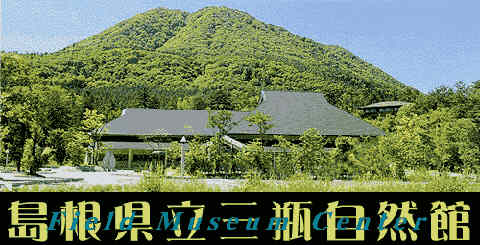
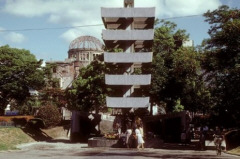
Mt. Sanbe
Hiroshima Memorial
Australia 
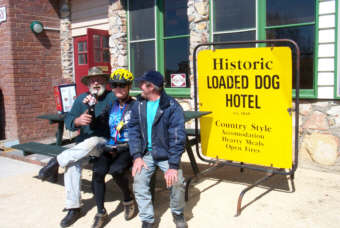
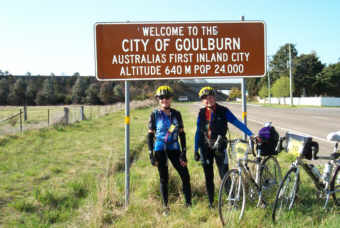
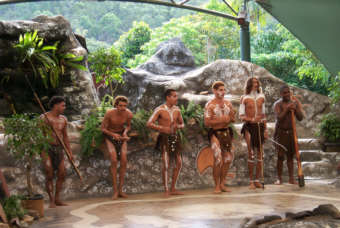
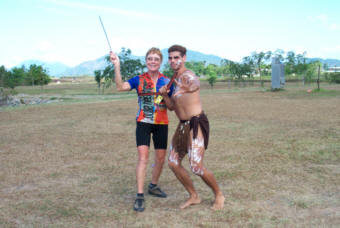
 Odyssey Riders and Staff
Odyssey Riders and Staff
